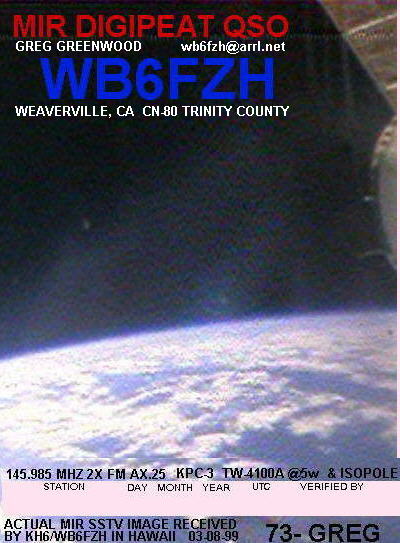Packet Digipeat QSOs Via MIR Space Station
WB6FZH's Special MIR Digipeat QSL CARD


Amateur Radio Operators all over the world communicated for many years with the Russian MIR Space Station. First with voice, then computer generated written packet messages and eventually Slow-Scan Television Images brought us images of the crew, it's interior and spectacular views out the window.
The equipment on MIR was inexpensive off-the-shelf type consumer equipment sent to MIR on robot supply ships. The antenna mounted on the outside of MIR is the same type that is on the roof of WB6FZH's Dodge Van, made in the USA. The 2 meter transceivers that sent voice, packet and SSTV can be found in vehicles and homes around the world made in Japan. The power supply that allowed use of the solar energy system provided by Radio Amateurs in Germany . The Digital device that turned computer keystrokes and packet messages on computer screens into messages to and from Earth and back, made in USA. The special electronic filter that allowed the Russian Space Agency Radios to co-exist with the "Ham" Radio equipment in close quarters, made in Canada.
Here on Earth, the total value of the used equipment used was about $300, all far from state of the art, but priceless in the gift they provided.
From an elevation of 2300ft in Northern California's Trinity National Forest, Greg, WB6FZH, was lucky enough to regularly contact stations via the orbiting digipeater. The vertical antenna used was installed 20 years ago for local use, the Kenwood 2 meter FM transciever came from a box of emergency communication supplies, along with the KPC-3 Packet TNC and an old 286 laptop computer running satellite tracking and terminal programs. Together they generated and displayed signals that bounced between the mountains during orbits of various elevations and directions from a Space Station 300 miles above. This vehicle has been described in terms that range from an orbiting rust-bucket RV to humankind's greatest and longest manned space adventure. It will always be the closest that one ham radio operator will ever get to space travel.
The MIR's antenna footprint on the Earth, constantly changed as it's travel in orbit. From Northern California, signals could be copied from Canada in the North, Mexico to the South, California to the West and Missouri to the East. The computer screen displayed beacons, brief greetings and messages from other Ham Radio Operators that were sharing this exciting digital communications experiment.
Actual MIR packet screen-prints recieved from MIR in July and August of 1999 can be viewed via links to this article. The date/time of contacts, callsigns, text and other data is all there, mistakes and all. You may also see interaction with the MIR Personal Message System that allowed the upload and download of messages using the onboard BBS system worldwide. The screen prints reflect simple low power beacons, giving locations, email address and name to short chats between amateurs in real time.
As MIR's orbital radio footprint encountered populated areas of the planet, the amount of radio signals increased proportionally. In areas of dense population, packet radio signals collided, with luck often determining who's signal would be repeated for all to view. At KH6/WB6FZH near Honolulu, Hawaii it was not unusual to find a message in the packet mailbox of the station after a MIR pass, with the message originating 20 miles away, but traveling 300 miles up and hundreds of miles away and back to the same island in the Pacific. Only a small handful of Amateur Radio Operators regularly used the MIR system in the Hawaiian Islands.
The MIR Amateur Radio Station and it's experiments had so many sucessful aspects, that the few glitches were hardly remembered. The voice and digital radio signals were availiable for use as back-up and alternative communications. The many emergency situations on MIR were always noticed by experienced MIR communicators. When the station went to emergency power, the digipeater would go silent, and when the emergency had passed, it's power-up sequence was familiar, and one could gauge the severity of the situation. The morale boost of communicating with folks down on Earth was postitive, and added variety to life onboard. Imagine seeing some students from schools around the world on your small TV screen as they talk to Cosmonauts 300 miles above. The companion to the radio communication was the dedicated manned space email reflector, that had news from insiders days before they would be on CNN. Often NASA experts that were "Hams" would provide their insite, or special inside information to all reading the email.
You can imagine the void that is left when the cosmonauts powered down MIR, turned out the light, closed the hatch and rocketed home. The screen of the small laptop nolonger displayed "Greetings from the MIR Space Station" and the usual data and conversations left as the MIR passed by. The new International Space Station (ISS) will have an Amateur Radio presence and the testing of some of the equipment will be done on an upcoming US Shuttle mission in March of 2000. NASA, Energia, Japanese Space Agency and others all recognize the value of Amateur Radio in Space.
A few seconds of the last voice heard from MIR over N. CA is availiable in a .WAV file linked to this article. It is that of a French Astronaut Jean Paul, heard through the static as his signal bounced between the mountains.
UNDER CONSTRUCTION- First Draft
Last Updated: November 12, 1999
WB6FZH NEW WEBSITE w/LINKS- Under construction!